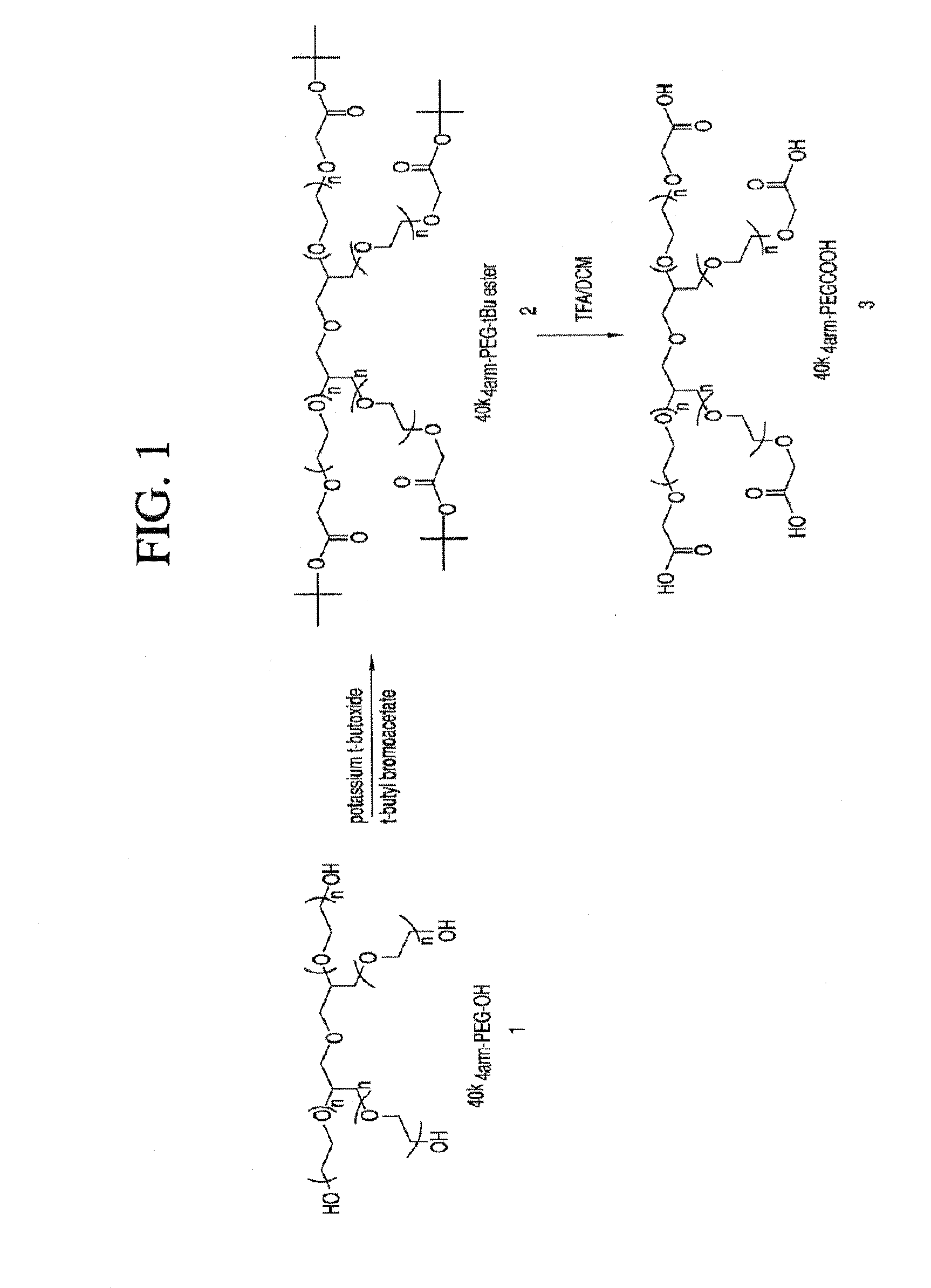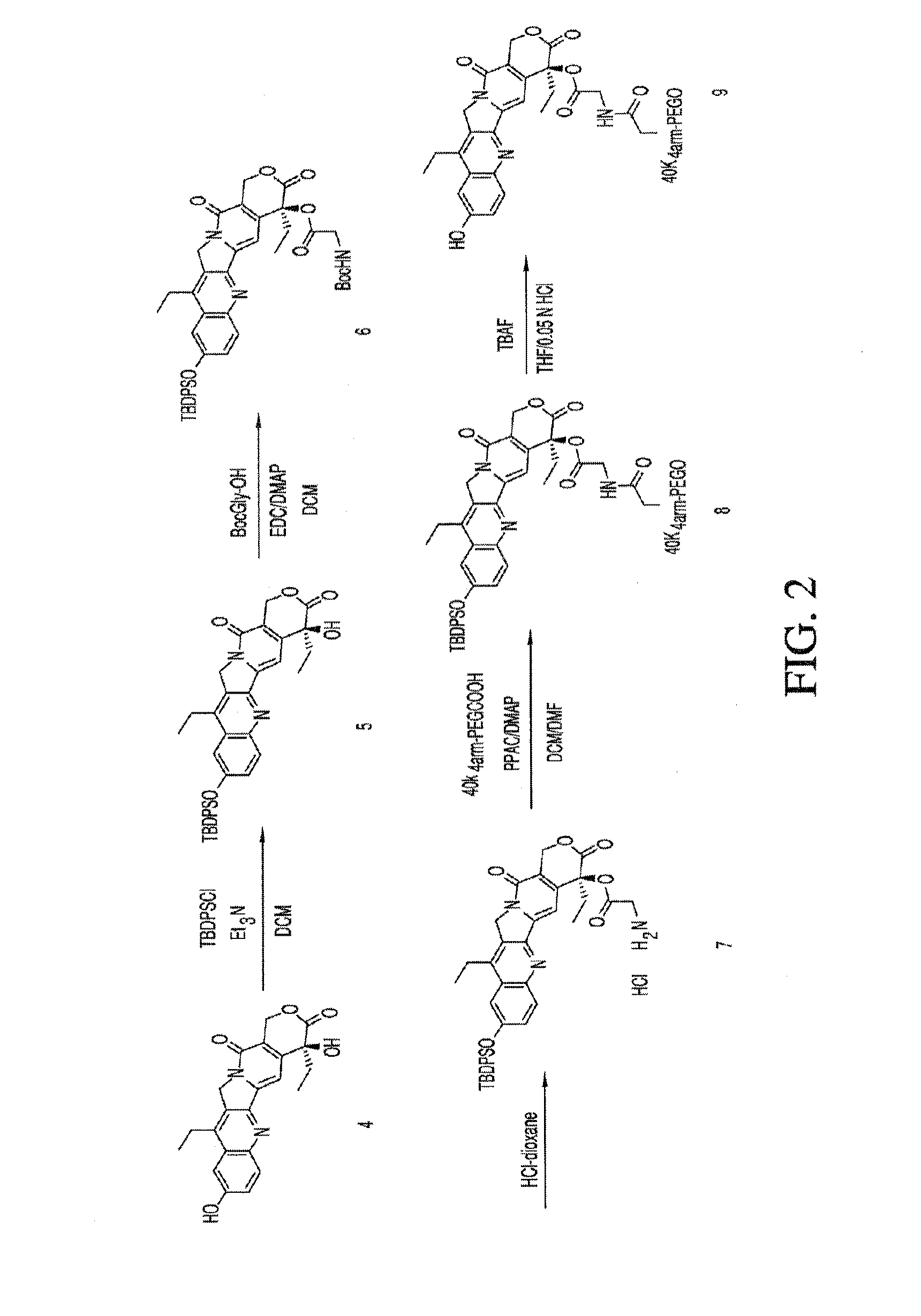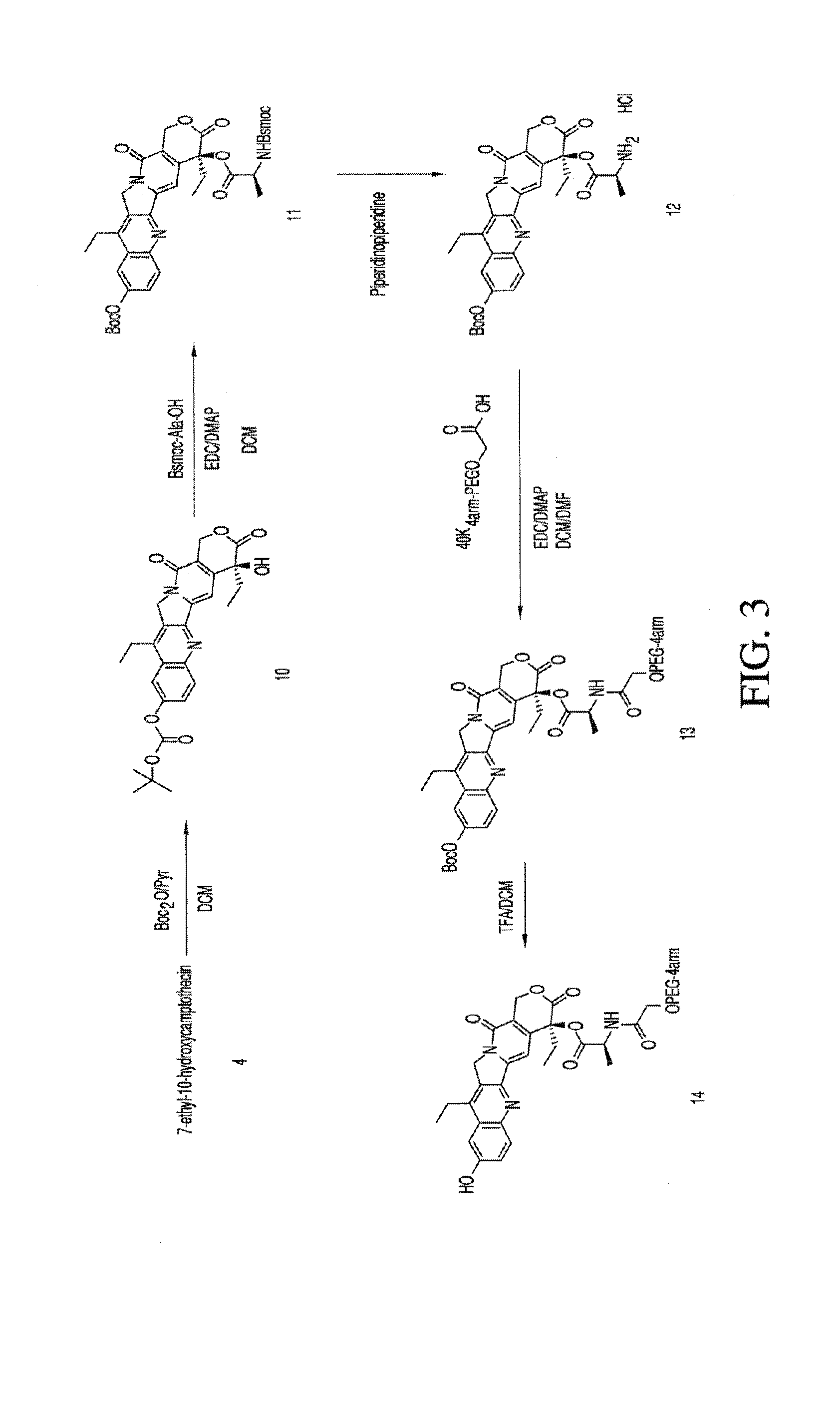Treatment of neuroblastoma with multi-arm polymeric conjugates of 7-ethyl-10-hydroxycamptothecin
a neuroblastoma and polymer conjugate technology, applied in the field of neuroblastoma treatment with polymeric conjugates of 7ethyl-10-hydroxycamptothecin, can solve the problems of cancer relapse, unhelpful screening infants for neuroblastoma, etc., to reduce toxicity and/or overcome other difficulties, eliminate or significantly reduce the immune response, and safely to patients
- Summary
- Abstract
- Description
- Claims
- Application Information
AI Technical Summary
Benefits of technology
Problems solved by technology
Method used
Image
Examples
example 1
40k4arm-PEG-tBu Ester (Compound 2)
[0238]40k4arm-PEG-OH (12.5 g, 1 eq.) was azeotroped with 220 mL of toluene to remove 35 mL of toluene / water. The solution was cooled to 30° C. and 1.0 M potassium t-butoxide in t-butanol (3.75 mL, 3 eq×4=12 eq.) was added. The mixture was stirred at 30° C. for 30 min and then t-butyl bromoacetate (0.975 g, 4 eq.×4=16 eq.) was added. The reaction was kept at 30° C. for 1 hour and then was cooled to 25° C. 150 mL of ether was slowly added to precipitate product. The resulting suspension was cooled to 17° C. and stayed at 17° C. for half hour. The crude product was filtered and the wet cake was washed with ether twice (2×125 mL). The isolated wet cake was dissolved in 50 ml of DCM and the product was precipitated with 350 ml of ether and filtered. The wet cake was washed with ether twice (2×125 mL). The product was dried under vacuum at 40° C. (yield=98%, 12.25 g). 13C NMR (75.4 MHz, CDCl3): δ 27.71, 68.48-70.71 (PEG), 80.94, 168.97.
example 2
40k4arm-PEG Acid (Compound 3)
[0239]40k4arm-PEG-tBu ester (compound 2, 12 g) was dissolved in 120 mL of DCM and then 60 mL of TFA were added. The mixture was stirred at room temperature for 3 hours and then the solvent was removed under vacuum at 35° C. The resulting oil residue was dissolved in 37.5 mL of DCM. The crude product was precipitated with 375 mL of ether. The wet cake was dissolved in 30 mL of 0.5% NaHCO3. The product was extracted with DCM twice (2×150 ml). The combined organic layers were dried over 2.5 g of MgSO4. The solvent was removed under vacuum at room temperature. The resulting residue was dissolved in 37.5 mL of DCM and the product was precipitated with 300 mL of ether and filtered. The wet cake was washed with ether twice (2×125 ml). The product was dried under vacuum at 40° C. (yield=90%, 10.75 g). 13C NMR (75.4 MHz, CDCl3): δ 67.93-71.6 (PEG), 170.83.
example 3
TBDPS-(10)-(7-ethyl-10-hydroxycamptothecin) (Compound 5)
[0240]To a suspension of 7-ethyl-10-hydroxycamptothecin (compound 4, 2.0 g, 5.10 mmol, 1 eq.) in 100 mL of anhydrous DCM were added Et3N (4.3 mL, 30.58 mmol, 6 eq.) and TBDPSCl (7.8 mL, 30.58 mmol, 6 eq.). The reaction mixture was heated to reflux overnight and then, was washed with a 0.2 N HCl solution (2×50 mL), a saturated NaHCO3 solution (100 mL) and brine (100 mL). The organic layer was dried over MgSO4, filtered and evaporated under vacuum. The residue was dissolved in anhydrous DCM and precipitated by addition of hexanes. The precipitation with DCM / hexanes was repeated to get rid of excess TBDPSCl. The solids were filtered and dried under vacuum to give 2.09 g of product. (65% yield). 1H NMR (300 MHz, CDCl3): δ 0.90 (3H, t, J=7.6 Hz), 1.01 (3H, t, J=7.3 Hz), 1.17 (9H, s), 1.83-1.92 (2H, m), 2.64 (2H, q, 6.9 Hz), 3.89 (1H, s, OH), 5.11 (2H, s), 5.27 (1H, d, J=16.1 Hz), 5.72 (1H, d, J=16.4 Hz), 7.07 (2H, d, J=2.63 Hz), 7.3...
PUM
| Property | Measurement | Unit |
|---|---|---|
| Time | aaaaa | aaaaa |
| Time | aaaaa | aaaaa |
| Mass | aaaaa | aaaaa |
Abstract
Description
Claims
Application Information
 Login to View More
Login to View More - R&D
- Intellectual Property
- Life Sciences
- Materials
- Tech Scout
- Unparalleled Data Quality
- Higher Quality Content
- 60% Fewer Hallucinations
Browse by: Latest US Patents, China's latest patents, Technical Efficacy Thesaurus, Application Domain, Technology Topic, Popular Technical Reports.
© 2025 PatSnap. All rights reserved.Legal|Privacy policy|Modern Slavery Act Transparency Statement|Sitemap|About US| Contact US: help@patsnap.com



